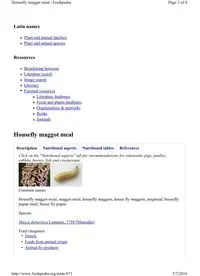Table Of ContentLatin names
Plant and animal families
Plant and animal species
Resources
Broadening horizons
Literature search
Image search
Glossary
External resources
Literature databases
Feeds and plants databases
Organisations & networks
Books
Journals
Housefly maggot meal
Click on the "Nutritional aspects" tab for recommendations for ruminants, pigs, poultry,
rabbits, horses, fish and crustaceans
Common names
Housefly maggot meal, maggot meal, housefly maggots, house fly maggots, magmeal, housefly
pupae meal, house fly pupae
Species
Musca domestica Linnaeus, 1758 [Muscidae]
Feed categories
• Insects
• Feeds from animal origin
• Animal by-products
Description
Nutritional aspects
Nutritional tables
References
Page 2 of 4
Housefly maggot meal | Feedipedia
5/7/2016
http://www.feedipedia.org/node/671
Related feed(s)
• Black soldier fly larvae (Hermetia illucens)
• Locust meal, locusts, grasshoppers and crickets
• Mealworm (Tenebrio molitor)
• Silkworm pupae meal
Description
The housefly (Musca domestica Linnaeus 1758) is the most common fly (Diptera) species. It is
a worldwide pest and a major carrier of diseases, as both the larvae (maggots) and the adult flies
feed on manure and decaying organic wastes. The ability of housefly maggots to grow on a
large range of substrates can make them useful to turn wastes into a valuable biomass rich in
protein and fat. Producing housefly maggot biomass in controlled conditions to feed farm
animals has been investigated since the late 1960s (Calvert et al., 1969; Miller et al., 1969).
Particularly, housefly larvae grown on poultry litter have shown to be used with great benefits
as a potential protein source in poultry nutrition (Pretorius, 2011). The use of housefly maggots
to feed fish and crustaceans in pond farming has been studied extensively since the late 2000s.
Other Musca species have been investigated to a lesser extent, such as the face fly Musca
autumnalis (De Geer) (Koo et al., 1980).
Life cycle
Under natural conditions, housefly eggs hatch after 8 to 12 hours. The larval stage lasts about 5
days and the pupal stage 4 to 5 days. This 10-day cycle can be shortened to 6 days under
controlled conditions. Adult female flies lay 500-600 eggs under natural conditions and more
than 2000 eggs under controlled ones. The flies lay eggs in moist substrates such as manure and
garbage heaps. Maggots feed for 4-5 days and then migrate to pupate in a dry place. The adult
fly feeds mainly on decaying organic matter. It needs to liquefy the food by regurgitating
droplets of saliva, thereby transmitting pathogens. The flies mate and lay eggs between feeding
periods. Large populations of flies can be obtained from relatively small amounts of substrate:
for instance, 450 grams of fresh manure can feed 1500 maggots (Hardouin et al., 2003).
Production
Various methods for producing and harvesting maggots have been described in the literature.
Early experiments investigated pupae rather than larvae because pupae collection was believed
to be easier (Calvert et al., 1969), but these technical issues have since been solved. Poultry
manure is the most common substrate cited in the literature for housefly rearing (Hardouin et
al., 2003; Akpodiete et al., 1997), sometimes using a fly attractant like animal offal or rotten
fruit (Odesanya et al., 2011). Other substrates mentioned in the literature include: pig manure
(Viroje et al., 1988; Zhu et al., 2012); cattle blood and wheat bran (Aniebo et al., 2008); cattle
blood and gut contents (Dankwa et al., 2002); cattle gut and rumen contents (Ekoue et al.,
2000); fish guts (Ossey et al., 2012); and a mixture of egg content, hatchery waste and wheat
bran (Ebenso et al., 2003). Usually the technique involves filling tanks or crates with manure
sprinkled regularly with water to keep the manure wet and attract the flies. A moisture range of
60 to 75% is suitable for larval development. Temperatures should be in the 25-30°C range
since maggots are inactive and develop poorly at temperatures below 20°C (Miller et al., 1974).
Page 3 of 4
Housefly maggot meal | Feedipedia
5/7/2016
http://www.feedipedia.org/node/671
Datasheet citation
Heuzé V., Tran G., 2015. Housefly maggot meal. Feedipedia, a programme by INRA, CIRAD, AFZ
and FAO. http://www.feedipedia.org/node/671 Last updated on October 21, 2015, 11:30
English correction by Tim Smith (Animal Science consultant) and Hélène Thiollet (AFZ)
Image credits
• Cory Doctorow
• Pavel Krok
Feedipedia - Animal Feed Resources Information System - INRA CIRAD AFZ and FAO © 2012-
2015 | Copyright | Disclaimer | Editor login
Maggots are harvested by several methods. In the flotation method, the manure is mixed with
water and the larvae and pupae float out to be collected with a sieve. In the screening method,
the manure is spread in a thin layer on a sieve (3 mm) placed over a basin under sunlight: the
larvae try to escape the light by passing through the screen and fall into the basin (Sogbesan et
al., 2006). The collected larvae are washed, killed in tepid or hot water and then dried and
milled. More sophisticated collection methods that make the larvae self-collect have been
designed (El Boushy et al., 1985).
Distribution
Houseflies are a common species worldwide. However, optimal production of maggots requires
warm temperatures (over 25°C) and moisture.
Processes
Most trials have been done with sun-dried (or oven-dried) and ground larvae. There have been
some attempts at defatting or hydrolyzing the maggots (Fasakin et al., 2003). Housefly maggots
can be also be fed live, especially to backyard chickens (Dankwa et al., 2002; Ekoue et al.,
2000) and fish (Ebenso et al., 2003; Madu et al., 2003).
Environmental impact
Housefly larvae are able to break up and dry out large amounts of poultry manure, and this
ability makes them a potential solution to waste management in poultry farms (El Boushy et al.,
1985).
Page 4 of 4
Housefly maggot meal | Feedipedia
5/7/2016
http://www.feedipedia.org/node/671

